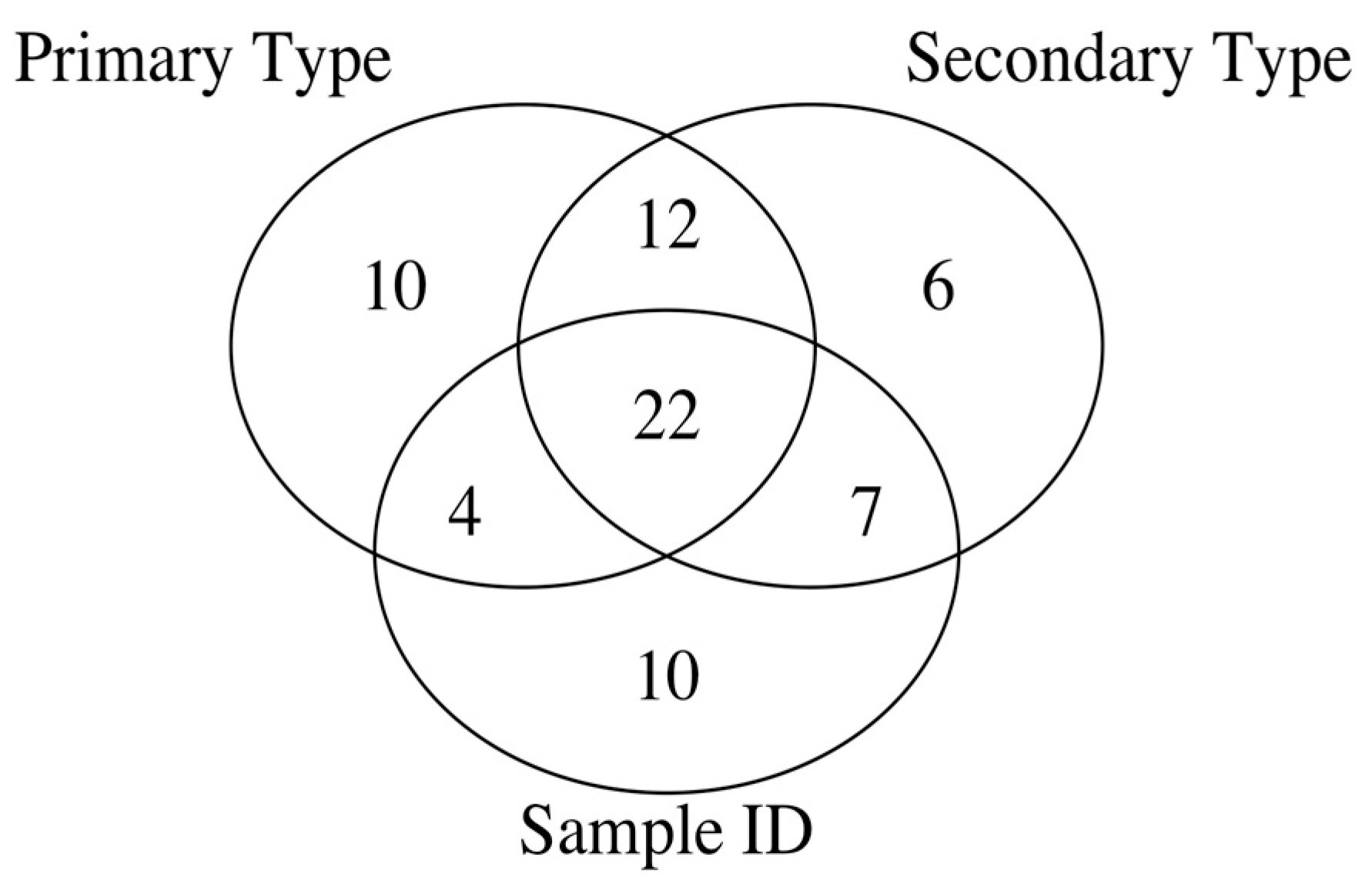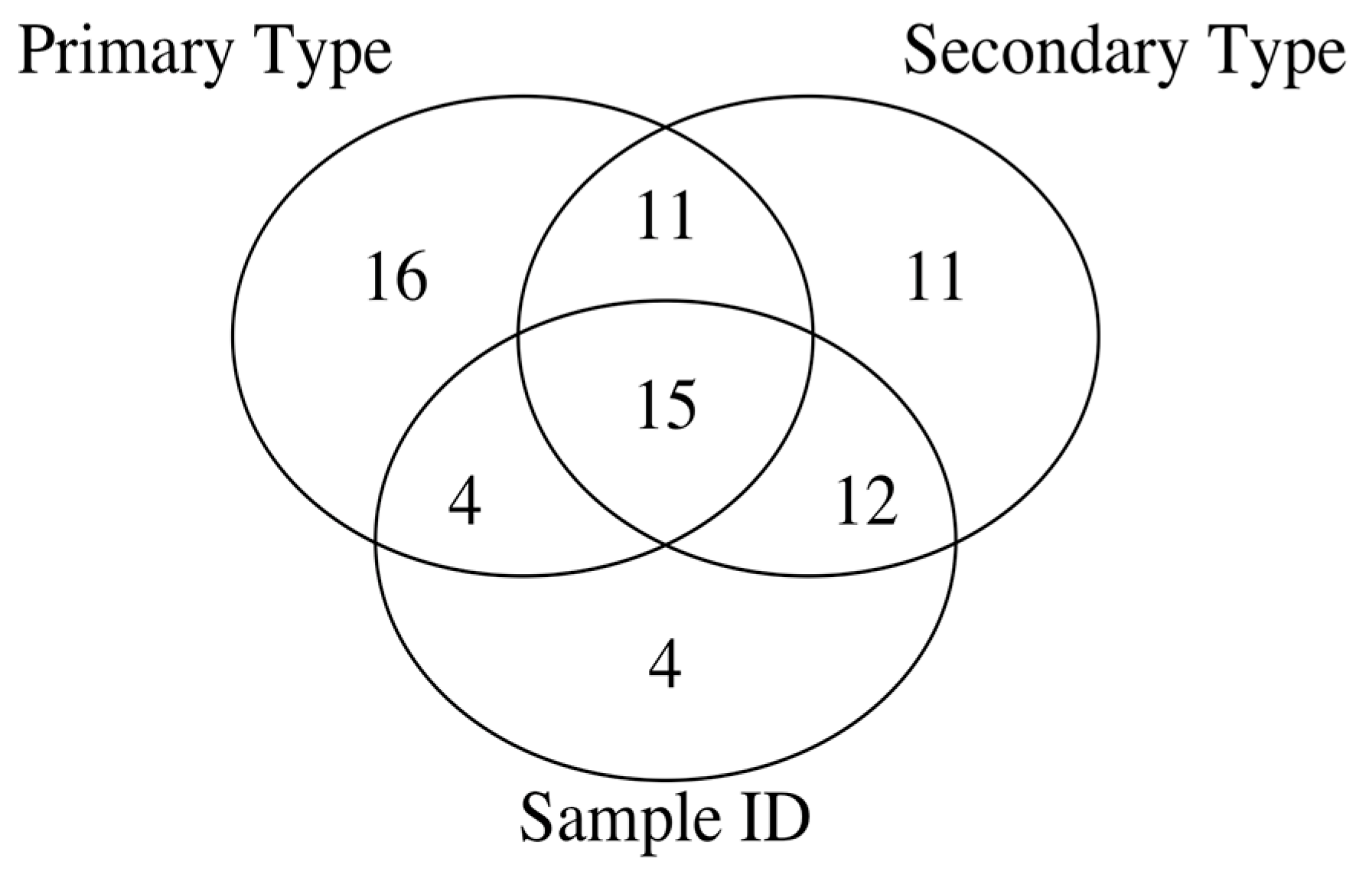Correction: Nag et al. Machine Learning-Based Classification of Lignocellulosic Biomass from Pyrolysis-Molecular Beam Mass Spectrometry Data. Int. J. Mol. Sci. 2021, 22, 4107
Reference
- Nag, A.; Gerritsen, A.; Doeppke, C.; Harman-Ware, A.E. Machine Learning-Based Classification of Lignocellulosic Biomass from Pyrolysis-Molecular Beam Mass Spectrometry Data. Int. J. Mol. Sci. 2021, 22, 4107. [Google Scholar] [CrossRef] [PubMed]


| Primary Type | Secondary Type | Sample ID | Counts | m/z Values |
|---|---|---|---|---|
| True | True | True | 22 | 60, 84, 85, 86, 91, 93, 94, 105, 114, 123, 124, 126, 135, 136, 139, 140, 144, 165, 184, 205, 209, 302 |
| False | True | True | 7 | 55, 58, 64, 115, 119, 125, 131 |
| True | False | True | 4 | 66, 197, 200, 296 |
| False | False | True | 10 | 79, 80, 100, 106, 113, 116, 161, 190, 211, 212 |
| True | True | False | 12 | 74, 92, 99, 103, 107, 110, 121, 129, 137, 148, 149, 166 |
| False | True | False | 6 | 77, 97, 111, 117, 153, 162 |
| True | False | False | 10 | 65, 70, 83, 109, 112, 174, 177, 192, 203, 219 |
| Primary Type | Secondary Type | Sample ID | Counts | m/z Value |
|---|---|---|---|---|
| True | True | True | 15 | 73, 93, 94, 105, 107, 114, 123, 124, 126, 135, 140, 154, 162, 219, 302 |
| False | True | True | 12 | 58, 91, 95, 97, 100, 119, 131, 136, 139, 190, 200, 332 |
| True | False | True | 4 | 60, 79, 165, 203 |
| False | False | True | 4 | 55, 80, 113, 418 |
| True | True | False | 11 | 57, 66, 84, 85, 86, 92, 120, 144, 149, 174, 192 |
| False | True | False | 11 | 68, 103, 106, 117, 122, 129, 130, 148, 153, 209, 211 |
| True | False | False | 16 | 65, 72, 74, 78, 81, 83, 98, 109, 110, 115, 161, 163, 166, 197, 205, 296 |
Disclaimer/Publisher’s Note: The statements, opinions and data contained in all publications are solely those of the individual author(s) and contributor(s) and not of MDPI and/or the editor(s). MDPI and/or the editor(s) disclaim responsibility for any injury to people or property resulting from any ideas, methods, instructions or products referred to in the content. |
© 2025 by the authors. Licensee MDPI, Basel, Switzerland. This article is an open access article distributed under the terms and conditions of the Creative Commons Attribution (CC BY) license (https://creativecommons.org/licenses/by/4.0/).
Share and Cite
Nag, A.; Gerritsen, A.; Doeppke, C.; Harman-Ware, A.E. Correction: Nag et al. Machine Learning-Based Classification of Lignocellulosic Biomass from Pyrolysis-Molecular Beam Mass Spectrometry Data. Int. J. Mol. Sci. 2021, 22, 4107. Int. J. Mol. Sci. 2025, 26, 9482. https://doi.org/10.3390/ijms26199482
Nag A, Gerritsen A, Doeppke C, Harman-Ware AE. Correction: Nag et al. Machine Learning-Based Classification of Lignocellulosic Biomass from Pyrolysis-Molecular Beam Mass Spectrometry Data. Int. J. Mol. Sci. 2021, 22, 4107. International Journal of Molecular Sciences. 2025; 26(19):9482. https://doi.org/10.3390/ijms26199482
Chicago/Turabian StyleNag, Ambarish, Alida Gerritsen, Crissa Doeppke, and Anne E. Harman-Ware. 2025. "Correction: Nag et al. Machine Learning-Based Classification of Lignocellulosic Biomass from Pyrolysis-Molecular Beam Mass Spectrometry Data. Int. J. Mol. Sci. 2021, 22, 4107" International Journal of Molecular Sciences 26, no. 19: 9482. https://doi.org/10.3390/ijms26199482
APA StyleNag, A., Gerritsen, A., Doeppke, C., & Harman-Ware, A. E. (2025). Correction: Nag et al. Machine Learning-Based Classification of Lignocellulosic Biomass from Pyrolysis-Molecular Beam Mass Spectrometry Data. Int. J. Mol. Sci. 2021, 22, 4107. International Journal of Molecular Sciences, 26(19), 9482. https://doi.org/10.3390/ijms26199482





